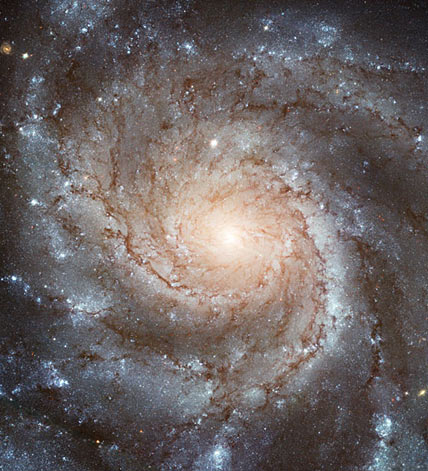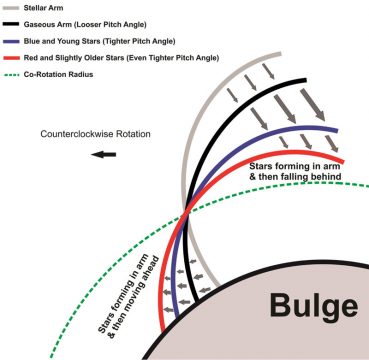Astronomers have found a unique trait of spiral arms that supports a longstanding idea about where these patterns come from.

NASA / ESA / K. Kuntz (JHU) / F. Bresolin (Univ. of Hawaii) / J. Trauger (JPL) / J. Mould (NOAO) / Y.-H. Chu (Univ. of Illinois, Urbana) / STScI
Arguably the prettiest objects in space are spiral galaxies. Young, bright stars trace the arms of these graceful whorls, and dark dust lanes act like galactic eyeliner to dramatically shade them.
In principle it’s easy to make a spiral arm. For various reasons, stuff in the disk sometimes clumps together, but the clump won’t stay a clump for long: stars and clouds near the galactic center circle the galaxy faster than the material farther out does, so over time the clump gets stretched into a spiral.
However, by this reasoning, the arm should quickly wrap itself around the galaxy’s center, destroying the spiral. That generally doesn't happen. Thus for at least half a century, astronomers have debated why these patterns persist. Maybe, many have suggested, stars don’t actually create the pattern — instead, they’re just passing through it. The arms instead would arise thanks to what are called density waves. Now, observations published in the August 10th Astrophysical Journal Letters provide long-looked-for evidence that these waves do exist.
Yield to Oncoming Stars
If you’ve ever been in a slowdown on the highway, you’ve experienced a density wave. Cars whizzing down the road encounter a region where, for whatever reason, they have to decelerate. Once they’ve passed it, they speed up again. Yet even though cars are successfully passing through the jam, the slow stretch persists and keeps propagating along the highway.
The same thing happens (we think) in spiral galaxies. Even as a clump in the disk stretches into a spiral, all the stars and clouds keep moving through that arm, just as cars continue to pass through a highway choke point. Essentially, clouds and stars slow down and speed up again in a chain reaction — a density wave — that moves through the galaxy.

Hamed Pour-Imani et al. / Astrophysical Journal Letters 827:L2, 2016 August 10. © AAS, reproduced with permission
The reason we can see this spiral pattern is because as it passes through the galaxy the density wave compresses gas clouds, triggering star formation. The youngest, brightest stars will thus be nearest the wave and trace out an arm. As stars move out of the wave and spread out across the disk they will age and these biggest, brightest stars will die off, preventing the arm from totally winding up.
But that doesn’t mean there’s no winding. An important prediction comes out of this scenario: how tightly wound a spiral’s arms appear depends on which population of stars you observe. As time goes on the stars get farther from the wave, and — because the inner stars move faster and the outer stars move slower — their orbital motions do wind the arm they’re tracing, tightening the spiral over time.
But because the hot, bluish, live-fast-die-young ones kick the bucket soon after they encounter the density wave, they’ll only trace loosely wound arms. Conversely the older, redder stars will trace more tightly wound arms. So if astronomers look at a galaxy in wavelengths that pick up young stars, they’ll see a more relaxed spiral than if they look in wavelengths that pick up old stars.
Density Waves Detected
Until now, astronomers hadn’t conclusively seen this effect. But the new study by Hamed Pour-Imani (University of Arkansas) and colleagues is convincing proof in its favor. The team compiled archival images of 28 spiral galaxies in far-infrared, near-infrared, optical, and ultraviolet wavelengths. The far-infrared and ultraviolet wavelengths pick up star-forming regions, while optical and near-infrared probe older stars.
The team checked its results three ways and sure enough, it found exactly what’s predicted: arms traced by older stars hug the galactic centers more tightly than those traced by star-forming regions. The result is a neat confirmation that density waves exist.
Reference: H. Pour-Imani et al. “Strong Evidence for the Density-Wave Theory of Spiral Structure in Disk Galaxies.” Astrophysical Journal Letters. August 20, 2016.
Learn more about all things astronomy with a subscription to Sky & Telescope.
 6
6
Comments
Hal Heaton
September 2, 2016 at 6:52 pm
This appears to be an interesting paper, which I have yet to read. The underlying fundamental question is what causes density waves? For example, what could cause a structured gravitational potential to act over such enormous distances? And what causes that pattern to take on different forms in different galaxies (e.g., 2-arm, 3-arm spirals) or perhaps at different distances (i.e., z)?
You must be logged in to post a comment.
Camille M. CarlislePost Author
September 6, 2016 at 3:37 pm
Yes, I took that bit out of the blog -- it's rather confusing, because *why* the waves exist is an open question. Something happens gravitationally to cause clumping in the galaxy's disk, but that could be the tidal yank of a passing galaxy, the pileup of giant molecular clouds in the disk, or orbital resonances between two lumps of stuff in the galaxy. In the last scenario, if a bit of material completes an orbit around the galactic center in a whole fraction of the time that material farther out does, that’ll build up the gravitational influence one clump has on the other. That in turn would create spots of higher and lower density. Any or all of these might be at play.
You must be logged in to post a comment.
Jim-Baughman
September 3, 2016 at 4:55 pm
Since spiral galaxies often exhibit the same structure as hurricanes and water spiraling down a drain I’d enjoy seeing a study linking these three phenomena.
Also, it is crucial to remember that a galaxy’s stars are not in orbit around the nucleus of the galaxy—how could the 100 billion solar mass of the Milky Way orbit a (relatively) miniscule 4-million solar mass black hole? Planets orbit the Sun because it contains 98% of the mass of the solar system, and thus it can direct the distribution and motion of its captives. Orbital mechanics do not apply to galactic structures, but those of eddies and cyclones.
You must be logged in to post a comment.
William-Perkins
September 5, 2016 at 1:12 pm
Read about this in Frank Shu's The Physical Universe: An Introduction to Astronomy (pp. 275-285) some time ago. Nice to see the hypothesis tested more rigorously with Spitzer. Thank you for bringing this to your readers' attention. Here is a pointer to the arXiv article in its entirety
http://arxiv.org/pdf/1608.00969v1.pdf
You must be logged in to post a comment.
Lou
September 7, 2016 at 8:57 am
It's a shame the team didn't provide an animation of the effect, but in my search for one, I did find a good one to illustrate the traffic analogy: https://www.youtube.com/watch?v=iHzzSao6ypE
You must be logged in to post a comment.
Vad-Falcone
September 7, 2016 at 6:08 pm
One of the first signs of dark matter was that the edge of galaxies was spinning faster than predicted by Newton's laws. In this case, shouldn't dark matter also slow down the wrapping up of spiral arms?
You must be logged in to post a comment.
You must be logged in to post a comment.